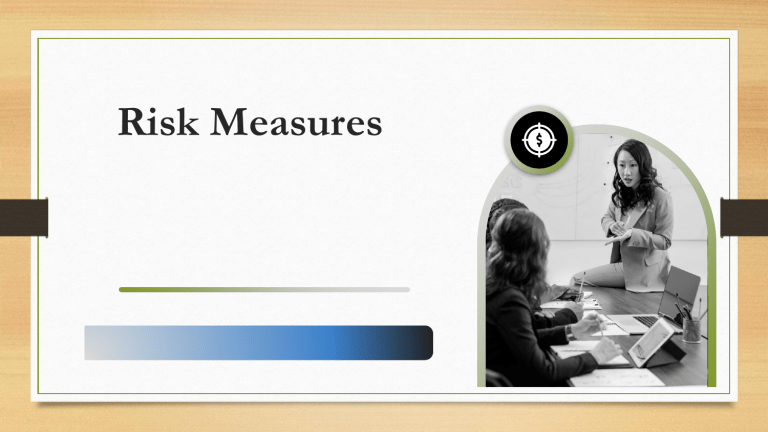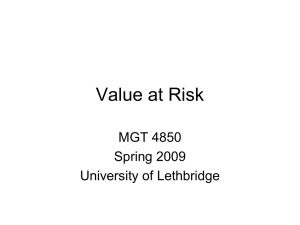
Risk Measures Here is where the presentation begins FOCUS OF THIS CHAPTER Defining and measuring risk • Volatility • VaR (Value–at–Risk) • ES (Expected Shortfall) • Holding periods • Scaling and the square–root–of–time Notations p Probability Q Profit and loss q Observed profit and loss w Vector of portfolio weights X and Y Refer to two different assets '(.) Risk measure # Portfolio valued dividends Defining Risk General Definition • No universal definition of what constitutes risk • On a very general level, financial risk could be defined as “the chance of losing a part or all of an investment” • Large number of such statements could equally be made, many of which would be contradictory Stock indices • Which asset do you prefer? • Standard mean variance analysis indicates that all three assets are equally risky and preferable • Since we have the same mean E(A) = E(B ) = E(C ) = 0 • And the same volatility σA = σB = σC = 1 If one uses mean variance analysis one is indifferent between all three Which asset is preferred by MV? • • If, however, one asks anybody which asset they would prefer, they probably would have a personal preference for one The most popular speculative financial asset in the world is inverted C — lottery tickets So what happened? • • • • • The model — mean variance — comes with a set of assumptions that are beneficial for creating a practical investment model But at the same time inconsistent with people’s risk preference Oftentimes that is not important But sometimes it is Recall “all models are wrong, some models are useful” Three investment choices Suppose Tom, Peter and Mary all have the same amount of money to invest • All have access to the same investment technology • All are contemplating putting $1 million into Amazon • Tom is a day trader, aiming to buy and sell within a week • Peter is a fund manager, and his bonuses depend on quarterly performance Mary is 22 years old, planning to retire in 40 years and expects to die in 70. She is saving for her pension that needs to be available when she’s 90 years old and far from able to manage her own money Their choices • • • • • • While faced with same technology, their preferences are different And consequently they will evaluate the three investment choices A, B , C differently Mary will unequivocally pick C It’s quite possible Tom does as well because she would not be a day trader if she didn’t like risk Peter would pick A or B , probably the latter Which asset is “better”? • • a. b. • There is no obvious way to discriminate between the assets One can try to model the underlying distribution of market prices and returns of assets, but it is generally unknown. can identify by maximum likelihood methods or test the distribution against other other distributions by using methods such as the Kolmogorov-Smirnov test Practically, it is impossible to accurately identify the distribution of financial returns Risk is a latent variable • Financial risk is cannot be measured directly • Risk has to be inferred from the behavior of observed market prices • e.g. at the end of a trading day, the return of the day is known while the risk is unknown Risk measure and risk measurement Present in most financial returns Risk measure a mathematical concept of risk Risk measurement a number that captures risk, obtained by applying data to a risk measure Volatility Volatility The standard deviation/error of returns • • • a. b. Volatility is the standard deviation of returns Main measure of risk in most financial analysis It is a sufficient measure of risk when returns are normally distributed For this reason, in mean-variance analysis the efficient frontier shows the best investment decision If returns are not normally distributed, solutions on the efficient frontier may be inefficient Volatility • The assumption of normality of return is violated for most if not all financial returns - See Chapter 1 on the non-normality of returns • For most applications in financial risk, volatility is likely to systematically underestimate risk Value–at–Risk (VaR) HISTORY • • • • Until 1994, the only risk measure was volatility Then the JP Morgan bank proposed a risk measure called Value-at-Risk and a method to measure it, called Riskmetrics. Why would JP Morgan do that — to be able to reduce its level of capital It used to be called the 415 report because it was created because the chairman of the bank wanted a single measurement of the bank’s risk in time for the treasury meeting at 4:15 PM VaR Value-at-risk is a statistical measure of the riskiness of financial entities or portfolios of assets. It is defined as the maximum dollar amount expected to be lost over a given time horizon, at a pre-defined confidence level. • • The most common risk measure after volatility VAR is determined by three variables: a specific time period, a confidence level, and the size of the possible loss. VaR • • Suppose you hold a $1 million portfolio of stocks tracking the S&P 500 index. For the purpose of our discussion we may assume that To address the question of how much this portfolio could lose on a “bad day,” one could specify a particular bad day in history – say the October 1987 stock market crash during which the market declined 22 percent in one day. Which probability should we use? • • • • VaR levels of 1% – 5% are very common in practice Regulators (Basel II) demand 1% But less extreme numbers, such as 10% are often used in risk management on the trading floor More extreme lower numbers, such as 0.1%, may be used for applications like economic capital, survival analysis or longrun risk analysis for pension funds Computing VaR for a single asset For a single asset using daily returns data at confidence level c, the VaR is computed as: 𝑉0 𝛼𝜎 Where; 𝑉0 is the initial value of the asset 𝛼 the number of the standard deviation below the mean corresponding to (1-c ) quantile of the normal distribution 𝜎 is the standard deviation of the asset’s return Computing VaR for a single ass asset Prob(X<z) • α 0.1% 0.5% -3.090 -2.576 1.0% 2.5% 5% 10% -2.326 -1.960 -1.645 -1.282 For 95% confidence level, c is equal to 0.95 (1-c) =(1-0.95)=0.05 which can be expressed as 5% The corresponding value of α is 1.645 Computing VaR for a single asset • • • Suppose that an investor’s portfolio consists of $10,000 worth of IBM stock Assume the standard deviation of the stocks’ returns are 0.0189(1.89%) If the investor wants to know his portfolio’s VaR over the coming trading day at a 95% confidence level, how do yoy think it will be calculated? Computing VaR for a single asset 𝑉0 𝛼𝜎 = (10,000)(0.0189)(1.645) = 310.905 This means that there is a 5% chance that the individual will lose $310.91. Or that the portfolio would be valued at $9,689.09. Computing VaR for a single • • • VaR can be extended to different time horizons by applying the square root of time rule The square–root–of–time rule is commonly assumed when financial risk is time aggregated whereby high frequency risk estimates are scaled to a lower frequency T by the multiplication of √ T. According to this, the standard deviation increases in proportion to the square root of time • 𝜎𝑡−𝑝𝑒𝑟𝑖𝑜𝑑 = √𝑡𝜎1−𝑝𝑒𝑟𝑖𝑜𝑑 Computing VaR for a single asset • If an investor wants to know his portfolio’s VaR for the coming month at a 95% confidence interval based on the assumption that there are 22 days in a month, this would be calculated as; • 𝑉0 𝛼𝜎 =(10,000)(0.0189√22)(1.645) • = 1,458.27 Computing VaR for a single asset • Similarly, if the investor wants to know what his portfolio’s VaR is over the coming year, assuming that there are 252 trading days in a year, the calculations would be: • 𝑉0 𝛼𝜎 =(10,000)(0.0189√252)(1.645) • = 4,935.46 Computing VaR for a portfolio • • In order to compute VaR for a portfolio of two or more assets, the correlation between the assets must be explicitly considered The lower the correlation, the lower the resulting VaR Computing VaR for a portfolio The Value at Risk of a portfolio calculated by determining; • Weight(proportion of the total invested) of each asset in the portfolio • Standard deviation of each asset’s rate of return in the portfolio • Correlations among the assets’ rate of returns in the portfolio Computing VaR for a portfolio Once the confidence level and time horizon have been chosen, the weights, volatilities and correlations can be combined using Markowitz’s approach to derive the portfolio’s VaR. 𝑇𝑜𝑡𝑎𝑙 𝑉𝑎𝑙𝑢𝑒 𝑜𝑓 𝑎𝑠𝑠𝑒𝑡 𝑇𝑜𝑡𝑎𝑙 𝑣𝑎𝑙𝑢𝑒 𝑜𝑓 𝑃𝑜𝑟𝑡𝑓𝑜𝑙𝑖𝑜 Weights= ∑( 𝑅𝑒𝑡𝑢𝑟𝑛𝑠1 −𝐴𝑣𝑒𝑟𝑎𝑔𝑒1 ) ∗ (𝑅𝑒𝑡𝑢𝑟𝑛𝑠2 −𝐴𝑣𝑒𝑟𝑎𝑔𝑒2 ) Covariance= 𝑆𝑎𝑚𝑝𝑙𝑒 𝑠𝑖𝑧𝑒−1 Computing VaR for a portfolio 𝐶𝑜𝑣1,2 Correlations= 𝜎1 𝜎2 Volatilities= √ (𝑤12 𝜎12 + 𝑤22 𝜎22 + 2𝑤1 𝑤2 𝐶𝑜𝑣1,2 ) Computing VaR for a portfolio Assume that a $100,000 portfolio contains $60,000 worth of Stock X and $40,000 of stock Y • Given the following data compute the VaR of this portfolio with a 95% confidence level over the coming; • Day • Month • Year Computing VaR for a portfolio Data 𝑤1 = 0.60 𝑤2 = 0.40 σ1 = 0.0163 σ2 = 0.0154 ρ1,2 = −0.191 Computing VaR for a portfolio Exercise Find the VaR at 95% confidence level Expected Shortfall (ES) Expected Shortfalls It is known by several names, including 1. ES 2. Expected tail loss 3. Tail VaR Expected Shortfall Expected shortfall is a risk measure sensitive to the shape of the tail of the distribution of returns on a portfolio, unlike the more commonly used value-at-risk (VAR). Expected shortfall is calculated by averaging all of the returns in the distribution that are worse than the VAR of the portfolio at a given level of confidence. For instance, for a 95% confidence level, the expected shortfall is calculated by taking the average of returns in the worst 5% of cases. Expected Shortfall ES = E(Loss|Loss >VaR) Expected value of the loss given that the loss is greater than VaR “a probabilty weighted average of tail losses” Pros and cons Pros • ES in coherent and VaR is not • It is harder to manipulate ES than VaR Cons To calculate ES we first have to know VaR and then integrate over the tail from VaR to minus infinity • That means in practice that we need more calculations for ES than VaR Length of holding periods • In practice, the most common holding period is daily • Shorter holding periods are common for risk management on the trading floor • where risk managers use hourly, 20-minute and even 10 minute holding periods • this is technically difficult because intraday data has complicated patterns Longer holding periods • Holding periods exceeding one day are also demanding • the effective date the sample becomes much smaller • one could use scaling laws • Most VaR forecasts require at least a few hundred observations to estimate risk accurately • For a 10-day holding period will need at least 3,000 trading days, or about 12 years • In most cases data from 12 years ago are fairly useless





